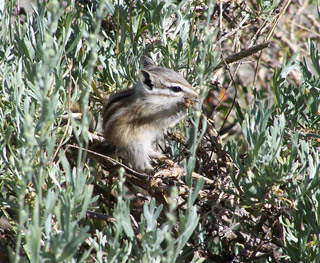Yosemite’s alpine chipmunks take genetic hit from climate change
Global warming has driven Yosemite's alpine chipmunks to higher ground, prompting a startling decline in the species' genetic diversity. The genetic erosion occurred in the relatively short span of 90 years, highlighting the rapid threat changing climate can pose to a species, and putting the alpine chipmunk on a trajectory toward extinction.
February 19, 2012
Global warming has forced alpine chipmunks in Yosemite to higher ground, prompting a startling decline in the species’ genetic diversity, according to a new study by researchers at the University of California, Berkeley.

An alpine chipmunk (Tamias alpinus) is shown at Yosemite’s Ten Lakes Pass at an elevation of 9,631 feet. (Risa Sargent photo)
The study, appearing Sunday, Feb. 19, in the advance online publication of the journal Nature Climate Change, is one of the first to show a hit to the genetic diversity of a species because of a recent climate-induced change in the animals’ geographic range. What’s more, the genetic erosion occurred in the relatively short span of 90 years, highlighting the rapid threat changing climate can pose to a species.
With low genetic diversity a species can be more vulnerable to the effects of inbreeding, disease and other problems that threaten species survival, the researchers said.
“Climate change is implicated as the cause of geographic shifts observed among birds, small mammals and plants, but this new work shows that, particularly for mountain species like the alpine chipmunk, such shifts can result in increasingly fragmented and genetically impoverished populations,” said study lead author Emily Rubidge, who conducted the research while a Ph.D. student at UC Berkeley’s Museum of Vertebrate Zoology and the Department of Environmental Science, Policy and Management. “Under continued warming, the alpine chipmunk could be on the trajectory towards becoming threatened or even extinct.”
Rubidge worked with Craig Moritz, professor of integrative biology and director of the Museum of Vertebrate Zoology; James Patton, professor emeritus of integrative biology and curator of the Museum of Vertebrate Zoology; and Justin Brashares, associate professor in the Department of Environmental Science, Policy and Management.
The new findings build upon previous research that found major shifts in the range of small mammals in Yosemite National Park since the early 1900s. In 2003, biologists at UC Berkeley began an ambitious resurvey of Yosemite’s birds, mammals, reptiles and amphibians, retracing the steps originally taken between 1914 and 1920 by Joseph Grinnell, founder and former director of the Museum of Vertebrate Zoology.
The Grinnell Resurvey Project, led by Moritz and museum colleagues, found that many small mammals in Yosemite moved or retracted their ranges to higher, cooler elevations over the past century, a period when the average temperature in the park increased by 3 degrees Celsius, or about 5.4 degrees Fahrenheit.

Emily Rubidge shown at a rocky slope above Tuolumne Meadows at Yosemite National Park. This is an area where alpine chipmunks were abundant in the past, but have now disappeared. (Cole Burton photo)
It is no surprise that the alpine chipmunk (Tamias alpinus) would be more sensitive to the temperature change, since it is a high-elevation species endemic to California’s Sierra Nevada, the researchers said. In the early 1900s, Grinnell and colleagues sighted alpine chipmunks at elevations of 7,800 feet. Now, the alpine chipmunk appears to be sticking to even higher elevations, retracting its range by about 1,640 feet upslope.
To test the genetic impact from that loss of geographic range, researchers compared genetic markers from 146 modern-day alpine chipmunks with those from 88 of their historical counterparts. Samples were collected from seven paired sites throughout Yosemite.
As a control, the researchers also looked at the genetics – both historic and modern – of lodgepole chipmunks (Tamias speciosus), a lower elevation species that had not changed its range over the past century.
The analysis of genetic markers revealed a significant decline in “allele richness” among the recently sampled alpine chipmunk populations compared with their historic counterparts. Moreover, the researchers noted that the modern chipmunks were more genetically differentiated across sites than in the past, a sign of increased fragmentation in the alpine chipmunk population.
In comparison, there were no significant changes in genetic diversity detected among the lodgepole chipmunks, a species found at elevations from 4,900 to 9,800 feet.
“Much of what we read and hear about the effects of climate change on biodiversity is based on model projections and simulations, and these models typically involve many moving parts and lots of uncertainty,” said Brashares. “Thanks to the baseline provided by Joseph Grinnell’s pioneering efforts in the early 20th century, we are able to go beyond projections to document how climate is altering life in California. The research led by Emily is novel and important because it shows empirically that climate change has led to the loss of genetic diversity in a wild mammal over the last several decades.”
Moritz added that this study exemplifies how patterns of change in California’s ecosystems can be uncovered through analyses of fossil, historic and modern records.
“At the heart of this whole enterprise is the incredibly dense historic record and specimens we have at UC Berkeley from 100 years ago,” said Moritz. “These collections allow us to conduct sophisticated analyses to better understand how ecosystems are reacting to environmental changes, and to create more detailed models of future changes.”
Other study co-authors are Marisa Lim, a UC Berkeley undergraduate student in integrative biology; and Cole Burton, former UC Berkeley graduate student in environmental science, policy and management (now a research associate at the University of Alberta in Canada).
Funding for this research was provided by the Natural Sciences and Engineering Research Council of Canada, UC Berkeley’s Museum of Vertebrate Zoology, the Yosemite Fund, the National Geographic Society and the National Science Foundation.